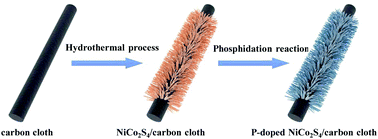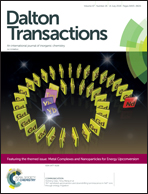P-Doped NiCo2S4 nanotubes as battery-type electrodes for high-performance asymmetric supercapacitors†
Abstract
NiCo2S4 is a promising electrode material for supercapacitors, due to its rich redox reactions and intrinsically high conductivity. Unfortunately, in most cases, NiCo2S4-based electrodes often suffer from low specific capacitance, low rate capability and fast capacitance fading. Herein, we have rationally designed P-doped NiCo2S4 nanotube arrays to improve the electrochemical performance through a phosphidation reaction. Characterization results demonstrate that the P element is successfully doped into NiCo2S4 nanotube arrays. Electrochemical results demonstrate that P-doped NiCo2S4 nanotube arrays exhibit better electrochemical performance than pristine NiCo2S4, e.g. higher specific capacitance (8.03 F cm−2 at 2 mA cm−2), good cycling stability (87.5% capacitance retention after 5000 cycles), and lower charge transfer resistance. More importantly, we also assemble an asymmetric supercapacitor using P-doped NiCo2S4 nanotube arrays and activated carbon on carbon cloth, which delivers a maximum energy density of 42.1 W h kg−1 at a power density of 750 W kg−1. These results demonstrate that the as-fabricated P-doped NiCo2S4 nanotube arrays on carbon cloth show great potential as a battery-type electrode for high-performance supercapacitors.



 Please wait while we load your content...
Please wait while we load your content...